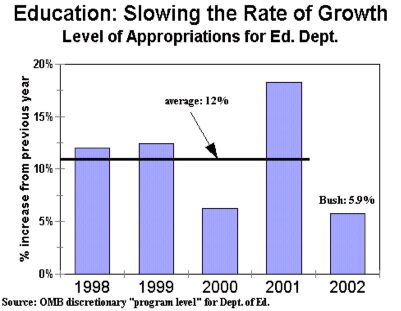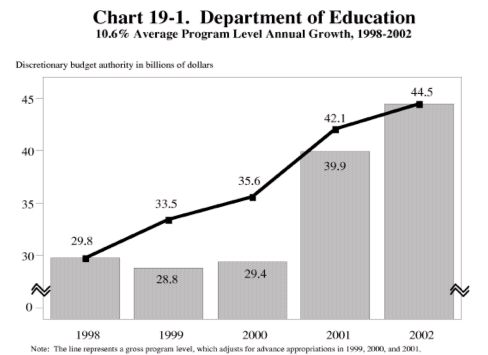Under President’s Budget, Education Funding
Would Grow 5.3 Percent
The Claimed 11.5 Percent Increase is a Distortion
by Richard Kogan
| View PDF version If you cannot access the file through the link, right-click on the underlined text, click "Save Link As," download to your directory, and open the document in Adobe Acrobat Reader. |
The Administration has said that education is the President’s highest priority. The budget states that the President grants the education department "the largest percentage spending increase of any Department (11.5 percent increase in 2002)." A closer look shows that the more accurate figure for the Education Department is a 5.9 percent increase, while the figure for all federal education funding is 5.3 percent.
After accounting for inflation, the increase proposed for education funding is 3.7 percent. After accounting for the increase in school-age population, the increase is 2.9 percent.
| 2001 | 2002 | $change | %change | |
| Department of Education, shown in budget | $39.9 | $44.5 | $4.6 | 11.5% |
| Dept. Ed. after correcting for the distortion of advance appropriations (source: OMB) | $42.1 | $44.5 | $2.5 | 5.9% |
| All education funding after correcting for the distortion of advance appropriations (source: CBO & OMB) | $44.1 | $46.4 | $2.3 | 5.3% |
| Adjusting the 2001 base to account for inflation (source: CBO) | $44.8 | $46.4 | $1.7 | 3.7% |
| Adjusting the 2001 base to account for population growth as well (source: Census) | $45.1 | $46.4 | $1.3 | 2.9% |
The 11.5 percent figure used by the White House represents the amount by which funding (appropriations, also called budget authority) would increase from 2001 to 2002 under the Bush budget. Budget tables show a dollar increase from $39.9 billion to $44.5 billion — an increase of $4.6 billion or 11.5 percent. This figure, however, is overstated for two reasons:
Previous Gimmicks. The previous Congress used a gimmick involving "advance appropriations" to artificially understate the amount of education funding it was providing in 2001. This gimmick hid, to a certain extent, the degree to which Congress was increasing education funding (and also funding for some other areas). The gimmick is explained in Appendix 1. The point, though, is simple — because the figure for 2001 understates education funding for that year, the increase from an understated 2001 figure to a correctly stated 2002 figure exaggerates the increase being proposed. The actual increase in funding for the Department of Education is $2.5 billion, not the claimed $4.6 billion.
The Office of Management and Budget has acknowledged that this is the case. In its February 28 budget book, OMB showed both the $4.6 billion figure and the more accurate $2.5 billion figure. OMB stated in this budget book that advance appropriations can cause distortions and that the correct figure for the increase is indeed $2.5 billion or 5.9 percent. We reprint on page 3 a graph and a box of text from the February 28 budget book. The heavy line in the graph shows that funding for the Education Department is slated to rise by $2.5 billion in 2002. The second bullet in the text box explains that when OMB "corrects for the distortion of advance appropriations," it finds that the budget "provides a $2.5 billion, or 5.9 percent increase, for Education Department programs."

Other Education Programs Are Reduced. The Department of Education is not the only source of funding for education programs. A number of smaller agencies, including the Smithsonian, the National Endowments, and the Library of Congress, also are part of the budget for education programs.(2) When all education funding is taken into account, the total funding increase for 2002 turns out to be $2.3 billion, or 5.3 percent.
How Does This Increase Compare With Previous Increases?
Comparable figures — adjusted for advance appropriations — exist for discretionary funding for the Department of Education. As Table 2 shows, the nominal 5.9 percent increase proposed for 2002 is smaller than the percentage increases enacted for the Education Department's budget in each of the past four years. In fact, over the past four years, Congress has increased funding for the Education Department an average of 12 percent per year. The president's proposal — a 5.9 percent increase — is half the recent average. In the case of education, the president can accurately be said to be "reducing the rate of growth."
These two boxes are taken directly from pages 104 and 103, respectively, of the Administration's February 28 budget book.

19. DEPARTMENT OF EDUCATION Highlights of 2002 Funding
|
| 1997 | $26.6 | Increase | |
| 1998 | $29.9 | $3.3 | 12.2% |
| 1999 | $33.5 | $3.6 | 12.1% |
| 2000 | $35.6 | $2.1 | 6.2% |
| 2001 | $42.1 | $6.5 | 18.2% |
| 2002 (proposed) | $44.5 | $2.5 | 5.9% |
Source: Department of Education |
|||
How Far Will the Money Go?
In ascertaining how far a given amount of money will go — whether it will buy more or better education for students — analysts need to account both for inflation and changes in the size of the school-age population.
As shown in Table 1, after taking inflation into account, the increase that the Administration's budget proposes for all education programs is $1.7 billion, or 3.7 percent. That is, funding for education will be 3.7 percent greater than CBO's "baseline" projection. Taking the increase in the size of the school-age population into account as well lowers the increase in 2002 to $1.3 billion, or 2.9 percent. That is, real per-capita education funding is scheduled to increase 2.9 percent in the president's budget. Because the president's budget would reduce appropriations for most domestic programs below the level needed to cover inflation and population, it is clear that education is a favored area. It is equally clear, however, that the amount of extra resources per student would grow at a relatively modest pace in 2002.
APPENDIX
Budget Gimmicks Distort Funding
Analyses and Inflate
Apparent Funding Increases
For the last two years, Congress has resorted to a budget gimmick to shift the fiscal year in which certain funding is counted, without in any way affecting the way the government spends money. Use of this gimmick plays a significant role in the Administration's claims that it is proposing an 11.5 percent increase in education funding next year.
To understand the gimmick, some background on education funding is necessary. Federal grants to school districts track the school year; the government makes monthly payments that start in August, as the school year begins, and run through the following July. Since the federal fiscal year runs from October through September, Congress traditionally has "forward funded" education programs. Each summer or fall, Congress appropriates a year's worth of funding to become available the following August and to be paid out over 12 months — in the last two months of the coming federal fiscal year and the first ten months of the succeeding federal fiscal year. Last year, however, Congress resorted to a budget gimmick. Instead of appropriating a lump sum for the 12 monthly payments to school districts, which by convention is shown in the federal budget accounts as being charged to the coming federal fiscal year (in this case, fiscal year 2001), Congress appropriated the funding in two pieces — one to cover the August and September payments for the coming federal fiscal year (which would be counted as part of the federal budget for fiscal year 2001) and the other to cover the remaining ten months of the school year, October through July. Because Congress did not make the second portion of the funding legally available until the following October, the first month of fiscal year 2002 (the month that this portion of the funding was scheduled first to be used in any case), the second batch of funding was not counted as part of the fiscal year 2001 budget but rather as fiscal year 2002 funding.
This change makes no difference to school districts. They receive their monthly funding on the same schedule either way. What this gimmick does is to understate artificially the amount of education funding in the federal budget for fiscal year 2001, since only two-twelfths of the 12-month cost of the program in question is counted as part of the 2001 budget. As a result, the amount of education funding for 2001 (and the overall amount of domestic discretionary funding as well) is artificially understated by $2.1 billion. The supposed education funding "increase" in the Bush budget from 2001 to 2002 overstates the actual increase in resources for education programs by this amount.
Pages 103 and104 of the budget book the Bush Administration issued on February 28 acknowledge that the budget figures that count this $2.1 billion as an increase in education funding in 2002 are a distortion. These pages of the budget contains a graph designed, as the budget explains, to "correct for the distortion of advance appropriations." This graph shows — and page 103 of the budget book states — that the funding increase for the Department of Education, widely billed by the White House as $4.6 billion or 11.5 percent in 2002, is actually $2.5 billion or 5.9 percent. Stated another way, $2.1 billion of the apparent "increase" the president says he is proposing for education in 2002 was already enacted by the previous Congress and signed into law by the previous president. The graph and text from pages 103 and 104 of the February 28 budget book are reproduced on page 3 of this analysis.
The Congressional Budget Office has issued data that correct for these distortions, as well as for similar distortions in several other parts of the budget. The CBO data show the amount of funding enacted last session, after correcting for the artificial understatement of the 2001 funding level that results from the timing shift the advance appropriations produce. The third row of the Table 1, on page 2 of this analysis, uses these CBO data as the base level of funding for 2001; these data provide the funding level as corrected to remove the distortion caused by advance appropriations. This table also uses the CBO baseline, which adjusts the 2001 base for inflation.
End Notes:
1. Budget of the United States Government, Office of Management and Budget, April 9, 2001, page 7.
2. The entirety of discretionary education funding is shown on pages 164 and 165 of the April 9 budget, in the three categories "elementary, secondary, and vocational education," "higher education," and "research and general education aids."